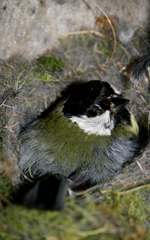Great tits also have age-related defects

The offspring of older great tit females are much less successful than those of younger mothers. Things mainly go wrong in the later stages of the upbringing, concludes evolutionary biologist Sandra Bouwhuis. For great tit females, it turns out to be a good idea to invest in generating offspring in the first years of life. Bouwhuis will be awarded a PhD by the University of Groningen on 18 March 2011 for her research into the ageing of great tits.
Bouwhuis researched ageing under female great tits (Parus major) in Wytham Woods (Oxfordshire, UK) and on the island of Vlieland (NL). She investigated the number of eggs and offspring and the reproductive success of this offspring, among other things.
Old mothers
Although great tits can live for nine years, breeding success declines rapidly after the age of two. Nevertheless, older great tits keep on breeding every year, says Bouwhuis: ‘They carry on to the bitter end’.
What is remarkable is that at the start of the breeding period there’s very little difference between the nests of older and younger females. Bouwhuis discovered, however, that massive mortality occurs just after the young leave the nest. ‘The parents still have to guide their young in the first crucial weeks after leaving the nest. Perhaps the older mothers have more trouble with that guidance; their young often fall prey to sparrowhawks, for example. Or maybe the older mothers have only been able to find less suitable places in the woods.’
Disposable body
Bouwhuis also demonstrated that it is beneficial for great tits to invest as much as possible in generating offspring during their first two years of life. Such hardworking great tits do age more swiftly than tits that get going at a more relaxed pace, but despite this early ageing being costly, the early breeders end up with the most descendants overall. ‘The costs and the benefits thus balance’, says Bouwhuis. ‘It’s the theory of the “disposable body” – investing in offspring instead of body maintenance. But why all great tits don’t follow this tactic is not clear.’
Ageing characteristics
Although the decline of the great tits is measureable by their breeding success, it’s not easy to spot the older ones by eye, says Bouwhuis: ‘They don’t have any clear ageing characteristics like wrinkles or grey feathers. What is being investigated at the moment is whether the yellow breast feathers change as the great tits get older. It’s perfectly possible that elderly great tits have ageing characteristics that we just don’t notice but which are very clear to other great tits.’
Male great tits
Bouwhuis does not yet know what’s going on with the male great tits. ‘This research concentrated on the females – males are also more difficult to catch during the breeding season.’ Male great tits are not always faithful, either, says Bouwhuis: ‘Males can have offspring with their permanent partner, but also with extramarital partners. That makes it very difficult to determine the exact number of offspring.’
Curriculum Vitae
Sandra Bouwhuis (Kampen, 1980) studied evolutionary biology at the University of Groningen. She conducted her PhD research at the Behavioural Biology research group at the University of Groningen and the Edward Grey Institute at the University of Oxford (UK). The research was financed by grants from NWO and the Schure-Beijerinck-Popping Fund. Bouwhuis will be awarded a PhD by the Faculty of Mathematics and Natural Sciences. Her supervisors were Prof. S. Verhulst, Prof. B.C. Sheldon, Prof. M.E. Visser and Prof. A.G.G. Groothuis. The title of her thesis is Great tits growing old – patterns and processes of ageing in a wild bird population.
More information
Sandra Bouwhuis, tel: 0044 1865 281 207, e-mail: sandra.bouwhuis zoo.ox.ac.uk
More news
-
02 December 2025
Student Menna Zahran wins Unilever Research Prize
-
27 November 2025
Aeroplane spotting using a radio telescope
-
26 November 2025
Why are shiny colours rare yet widespread in nature?
